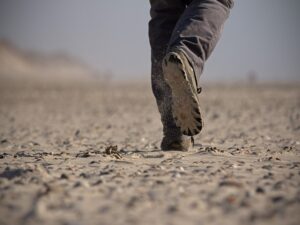Walking is an excellent strategy to enhance or preserve your fitness. Within only thirty min per day, you may improve your cardiorespiratory fitness. It improves your posture, loses weight, and develops your muscular strength and stamina. Going to walk, despite several other types of physical activity, is costless. It requires no specialized tools or instruction. For pleasure and wellness does not have to be restricted to solo strolls around the local routes. Running is a type of it. There are several questions that came to our minds. How many steps in a mile is one of them. It has the potential to transform emotional and physical health.
Safety Precautions while Walking:
Some of them are the following:
- Prior to a new exercise regimen, consult your physician for a regular examination.
- Select activities that are appropriate for your ages and fitness regime. To relax into and out of the workouts, heat up and cool down with a calm, easy commute.
- To prevent sores and musculoskeletal problems, wear sports garments and suitable sneakers.
- To reduce sunstroke, wear goggles, sunblock, tank tops, and a mask.
- If it showers, brings protective clothes to keep from getting muddy.
- To protect yourself from unpleasant animals, bring a walking aid or a cover.
- During and after the exercise, stay hydrated. Bring water with you if you’re going for a stroll.
How Running better than Gym?
Lifting weights using light dumbbells and exercise types of equipment is one of our favorite things to do. Running’s advantages offer a compelling justification for any person to try taking up the sport. Some of them are the following:
- It is often known as sprinting, is among the most effective aerobic workouts available. Trying to run for at least ten min per day can reduce the risk of stroke considerably. Athletes have a 50% decreased risk of death from heart illness.
- A good night’s sleep is to your physical health. While you rest, the body grows on its own. That’s why you feel energized once you awoke. However, try not to jog excessively later in the day. It can make it tricky to get a decent night’s rest.
- The further you move, the less likely you face chronic back pain when you become older.
- If you’re having trouble remembering things, get moving. It has both acute and protracted effects on the mind. Aerobic conditioning causes you to breathe and raises your pulse rate. It can help to increase the volume of your hippocampus that is essential for cognitive performance.
- Running for a few minutes can assist your immune response kicking in and help relieve if you’re feeling quite off. You can reduce your risk of cases of pneumonia by 43 percent if you practice cardiovascular activities like it for at least five working days per week.
- Sometimes people are running to find relief. The activity affects your mood, focus, and total general wellbeing. The sprinter’s rush is genuine.

Importance of Knowing the Steps in a Mile:
Understanding how many steps are in a mile has some unexpected advantages. It can help you control your fitness routine. There’s a growing belief in the walks you take. Whether on a handful of loops around in the playground or on a long haul. It can allow you to maintain your health. Users should first determine their initial daily steps and then form a strategy. How much and how quickly they exercise in a secure environment.
Measuring Steps in a Mile:
The human’s leg length is between 2.1 and 2.5 meters. It suggests that one mile requires almost 2,000 feet, and 10,000 leaps equal about 5 miles. Using a pedometer or wearable device is a simple method to keep records of daily walks. Begin by carrying the pedometer for one week daily basis. Apply it on as soon as you wake up and keep on till nighttime. In a notepad or diary, keep track of current movements. You’ll have your highest hourly walks by the completion of the week. You may well be shocked at how often steps you take each and every day, or even how many. A sensible objective is to raise your per-day moves by 500 a week until the user can quickly access 10,000 walks each day.
Dependence of Steps in a Mile:
It depends on the following:
- As your stride sizes vary depending upon the situation, even if you’re walking or running. Your sprinting pace is here.
- Your altitude or the height of your limbs because taller people seem to take the path.
- The duration of your leaps. The longer your glides are, the fewer walks you’ll cross a distance.
- Your ethnicity, particularly when running; men and women’s biomechanical typically alter their walk, resulting in variations in rising time.
Burning Calories in a Mile:
The number of calories consumed is by your fitness level. It is bodyweight, running, walking effectiveness, pace, and slope. The quicker you try to walk, the more energy you expend on average. It, therefore, has a significant impact on your health. If you need to burn the most calories, it’s an option to walk around the block. It is as rapidly as feasible. There are reasons to get in shape and burn calories if you consume well, rather than obsessing the count of calories. You expend when exercising, attempt to improve your speed and direction.
How to Remain Fit:
It is by following these steps:
- What motivates you to become in shape?
- Dining Good: Making dietary modifications will assist you in shape faster.
- Workout: Make it simple. Select an exercise you enjoy and engage in it on a regular basis.
- Set a target for yourself to hold you responsible.
- Encourage: Make a list of the people who matter to you. Encouragement and perhaps even turning up at your front entrance to exercise with you.
Final Words:
Knowing the advantages of muscular endurance and how engaged you ought to be can help you stay healthy and enhance your overall standard of living.

